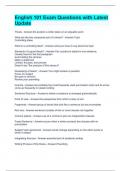Essay
A Level Psychology Biopsychology Topic essays
- Module
- Institution
This document contains all the possible Biopsychology 16 marker essays that could come up on your Psychology Paper 1 exam for the AQA examboard. It can also be used for shorter answers, or just some general revision for the topic. Great for AO3, as it also contains counter criticisms and issues and...
[Show more]












